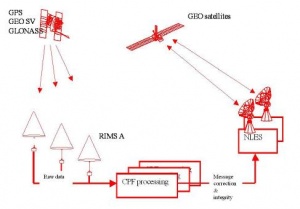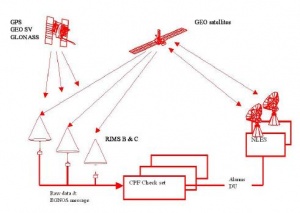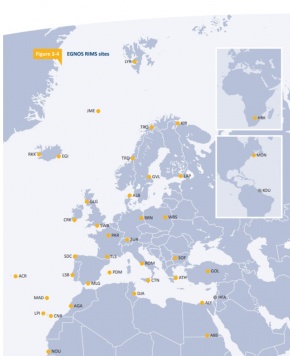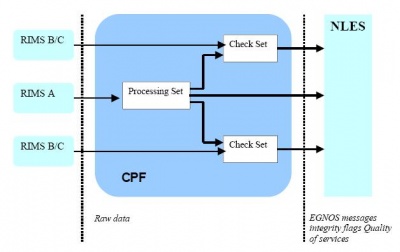If you wish to contribute or participate in the discussions about articles you are invited to contact the Editor
EGNOS Ground Segment: Difference between revisions
No edit summary |
No edit summary |
||
| Line 99: | Line 99: | ||
The messages elaborated by the CPF at the Master MCC are transmitted to the NLESs. The NLES stations receive the EGNOS messages from all the CPFs for the upload of the | The messages elaborated by the CPF at the Master MCC are transmitted to the NLESs. The NLES stations receive the EGNOS messages from all the CPFs for the upload of the | ||
data stream to the geostationary satellites and the generation of the GPS-like signal. Using the quality of service (QOS) and the integrity flags provided by the CPFs, the NLES | data stream to the geostationary satellites and the generation of the GPS-like signal. Using the quality of service (QOS) and the integrity flags provided by the CPFs, the NLES | ||
stations are able to select automatically the best CPF among the four available. For each of the three EGNOS geostationary satellites to upload, two dedicated NLES stations ( | stations are able to select automatically the best CPF among the four available. For each of the three EGNOS geostationary satellites to upload, two dedicated NLES stations (one active and one as a hot backup) are deployed, for a total of six operational NLES stations. | ||
{| style="#008542;background-color:#FDC82F;" cellpadding="5" cellspacing="0" border="1" | {| style="#008542;background-color:#FDC82F;" cellpadding="5" cellspacing="0" border="1" | ||
Revision as of 16:19, 25 May 2011
| EGNOS | |
|---|---|
| Title | EGNOS Ground Segment |
| Author(s) | GMV. |
| Level | Basic |
| Year of Publication | 2011 |
The EGNOS Ground Segment comprises a network of Ranging Integrity Monitoring Stations (RIMS), four Mission Control Centres (MCC), six Navigation Land Earth Stations (NLES), and the EGNOS Wide Area Network (EWAN) which provides the communication network for all the components of the ground segment. Two additional facilities are also deployed as part of the ground segment to support system operations and service provision, namely the Performance Assessment and Checkout Facility (PACF) and the Application Specific Qualification Facility (ASQF), which are operated by the EGNOS Service Provider (ESSP SAS).[1]
The EGNOS system is a widely distributed and redundant system and data flows from one subsystem to another subsystem have different level of criticality.
Critical Data Flow description
The EGNOS data flow is separated in two cycles that shall be completed in less than the 6 second timeframe in order to meet the EGNOS time to alarm requirements. These two cycles are:[2]
- Processing cycle: RIMS A data collection and message generation.
- Check cycle: RIMS B and C data collection and correction check.
Processing cycle: This cycle elaborates the correction and integrity information. The first step is the collection of GPS/GLONASS/GEO raw data through the channel A of the RIMS stations. These data consists of:
- Pseudo range measurements (code+phase) on GPS/GLONASS and EGNOS geostationary satellites signals through the channel A of the RIMS stations.
- Universal Time Clock (UTCop). The receiver of the RIMS located in Paris (at the LPTF premises) is connected to one of the reference atomic clock “UTCop” used for the coordinated elaboration of UTC. The measurements performed by this RIMS allows, once processed by EGNOS Central Processing Facility (CPF), to measure the time offset between the clock “UTCop” and the EGNOS Network Time (ENT). This information (UTC/ENT offset) is broadcast to the users in a dedicated augmentation message (MT12) allowing users to deduce the UTC time.
These data are sent to the CPF Processing Set in charge of processing the raw data for the generation of corrections and integrity messages. This process takes place in four main steps:
- Common pre-processing and validation. Input data from the RIMS are validated and processed to remove the systematic errors components like ionospheric and tropospheric delays. Carrier phase cycle slips are detected and removed, data are smoothed to reduce the random noise and, the residual multipath components are filtered out.
- Computation of EGNOS augmentation data. This stage is the core of the CPF Processing Set elaboration process and includes: the elaboration of corrections for the orbital and clock parameters of GPS, GLONASS and GEO satellites, the ionospheric vertical delays over the points (IGP) of a predefined two-dimensional grid and the estimations of residual errors (UDRE and GIVE) associated to the corrections.
- Internal Check and Quality Estimation: This step consists in the evaluation of the integrity of satellite and ionospheric corrections computed in the previous step verifying the consistency of the residual errors after the applications of the corrections. The result of the consistency check is translated into an indicator of the Quality of Service provided by the CPF Processing Set. This indicator is used by the NLES for the selection of the main CPF.
- Processing Output Message Management: This step consists in the generation and formatting of the messages according to the international standards and in the determination of the optimal sequence for the broadcast of the messages.
These four elaboration steps include a set of complex mathematical algorithms whose capabilities are directly driving the overall EGNOS performance. In particular, computation of the UDRE and GIVE is one of the most critical issues of the Processing Set as these bounding algorithms are vital to EGNOS integrity. These algorithms also impact on the continuity and availability of the EGNOS Signal in Space.
Once the EGNOS messages are generated and checked, they are sent to the NLES. Then the messages are used to modulate a GPS like signal, which is up-linked to EGNOS geostationary satellites and broadcast to users.
Check cycle: GPS/GLONASS/GEO raw data collected by the channels B and C of RIMS stations are sent to the CPF Check Set. The task of the CPF Check Set is to verify, independently from the CPF Processing Set, the user’s positioning integrity and, therefore, to verify the correctness of the messages generated by the CPF Processing Set before and after the broadcast to users. In particular, statistical tests are performed to verify the reliability of the corrections and the corresponding residual errors.
For the UERE and UDRE check, all measurements taken from a single satellite by a number of RIMS stations are combined to obtain the best statistical information on the pseudo-range error, UERE, and on its residual error, UDRE. Correction and residual error computed by the CPF Check Set are then compared with the corresponding values computed by the CPF Processing Set and already broadcast to users. If the values computed by the CPF Check Set deviate significantly from the CPF Processing Set values an integrity flag (not monitored) is then raised for the specific satellite.
For the GIVD and GIVE check, information from dual-frequency GPS measurements is combined into a single estimation of the ionospheric delay GIVD over the points (IGP) of a predefined two-dimensional grid together with the residual errors GIVE. Correction and residual error computed by the CPF Check Set are then compared with the corresponding values computed by the CPF Processing Set and already broadcast to users. If the values computed by the CPF Check Set deviates significantly from the CPF Processing Set values an integrity flag (not monitored) is then raised for the specific grid point IGP.
Non critical Data Flow description
The heart of the non-critical data flow is the Central Control Facility (CCF). All ground segment sub-systems send and receive data from the CCF. These are Monitoring and Control data but also EGNOS data destined to the archive. The following list details the content of exchange between a particular ground segment sub-system and the CCF.
- RIMS - The RIMS sends only raw data streams to the CCF in addition to the generic interface data. These streams of data are received by the communication handler, time
tagged and stored into the CCF archive and used by the Mission Monitoring Function.
- CPF - In addition to the generic interface data, this subsystem provides the CCF with RIMS status information as derived from the CPF computations and a subset of the
elaborated data (residual errors, ephemeris).
- PACF - The following data are exchanged with the support facility:
- Input: configuration items to download for the installation in the EGNOS Ground Segment, Maintenance Schedules generated by the planning function of the PACF, GPS, INMARSAT and ESA satellites status/schedule information provided regularly and on event.
- Output: periodic update of the archive databases and requests for maintenance activities if anomalous working conditions are detected in the EGNOS Ground Segment. The current configuration status is sent in case of changes.
- NLES: as the RIMS sub-system, the NLES sends only raw data streams to the CCF in addition to the generic interface data. As the RIMS data streams, these data are time tagged and stored into the CCF archive.
EGNOS RIMS
The main function of the RIMS is to collect measurements from GPS satellites and to transmit these raw data every second to the Central Processing Facilities (CPF) of each MCC. The initial configuration includes 34 RIMS sites located over a wide geographical area.
In order to improve the performance of the EGNOS system and enlarge the area where the EGNOS services can be used, an extension of the monitoring network is expected soon which will see the deployment of additional RIMS in La Palma, (Spain), Athens (Greece) and Alexandria (Egypt). A further extension is also planned in a slightly longer timeframe that should improve the EGNOS performance in the southern parts of the service area. Figure 3 shows the geographical distribution of the RIMS already in operation and the RIMS current under deployment.
EGNOS CPF
The Central Processing Facility (CPF) is a module of the Mission Control Centres that uses the data received from the network of RIMS stations to:[2]
- Elaborate clock corrections for each GPS satellite in view of the network of RIMS stations. These corrections are valid throughout the geostationary broadcast area (i.e. wherever the EGNOS signal is received).
- Elaborate ephemeris corrections to improve the accuracy of spacecraft orbital positions. In principle, these corrections are also valid throughout the geostationary broadcast area. However, due to the geographical distribution of the EGNOS ground monitoring network, the accuracy of these corrections will degrade when moving away from the core service area.
- Elaborate a model for ionospheric induced delay over the EGNOS service area in order to compensate for ionospheric perturbations to the navigation signals.
This function requires a dense network of monitoring stations. For this reason, the ionospheric model broadcast by EGNOS is not available for the whole geostationary broadcast area but is only provided for a region centred over Europe.
These three sets of corrections are then broadcast to users to improve positioning accuracy.
In addition, the CPF estimates the residual errors that can be expected by the users once they have applied the set of corrections broadcast by EGNOS. These residual errors are characterised by two parameters:
- User Differential Range Error (UDRE): this is an estimate of the residual range error after the application of clock and ephemeris error correction for a given GPS satellite.
- Grid Ionospheric Vertical Error (GIVE): this is an estimate of the vertical residual error after application of the ionospheric corrections for a given geographical grid point.
These two parameters can be used to determine an aggregate error bounded by the horizontal and vertical position errors. Such information is of special interest for Safety of Life users but may also be beneficial to other communities needing to know the uncertainty in the position determined by the user receiver.
The CPF includes a large number of monitoring functions designed to detect any anomaly in GPS and in the EGNOS system itself and is able to warn users within a very short timeframe (less than 6 seconds) in case of an error exceeding a certain threshold.
NLES
The messages elaborated by the CPF at the Master MCC are transmitted to the NLESs. The NLES stations receive the EGNOS messages from all the CPFs for the upload of the data stream to the geostationary satellites and the generation of the GPS-like signal. Using the quality of service (QOS) and the integrity flags provided by the CPFs, the NLES stations are able to select automatically the best CPF among the four available. For each of the three EGNOS geostationary satellites to upload, two dedicated NLES stations (one active and one as a hot backup) are deployed, for a total of six operational NLES stations.
| NLES stations | Geostationary satellites |
|---|---|
| Goonhilly (United Kingdom); Aussaguel (France) | Inmarsat AOR-E |
| Fucino (Italy); Goonhilly (United Kingdom) | Inmarsat IOR-W |
| Torrejon (Spain); Scanzano (Italy) | ESA ARTEMIS |
The two NLES stations connected to a specific geostationary satellite are totally interchangeable. The switch from the active station to the backup station is managed by the CPF running as master and occurs when the active station is no more broadcasting. The NLES broadcast may be interrupted because of internal failures or after the action of specific integrity mechanisms. In any case the system has been designed to avoid that the same satellite is connected with the two corresponding NLES stations at the same time. As the EGNOS geostationary satellites have no atomic clock on board (as GPS satellites) to steer the generation of GPS typical modulating codes (PRN codes), the EGNOS augmentation messages are combined with the PRN codes (assigned to EGNOS satellites) and with additional signals to form a preliminary EGNOS signal synchronized with the L1 frequency before the up-link. The NLES then merges the preliminary EGNOS signals with the up-link signals in C band (the up-link signals contain also other data streams addressed to the satellite). The geostationary satellite, acting as a transponder, filters and shift in frequency the EGNOS signals for the broadcast on the L1 frequency.
CCF
The EGNOS system is controlled through a Central Control Facility (CCF) located in each of the Mission Control Centres. These facilities are manned on a 24/7 basis in order to ensure permanent service monitoring and control.
The Central Control Facility is in charge of the monitoring and control of the entire EGNOS system. The main functions are:
- Monitor and control all the EGNOS ground subsystems.
- Monitor the system mission, the EGNOS satellites and predict the service performance.
- Archives all collected and produced data.
- Provide interface to PACF and ATC (Air Traffic Control).
There are four CCFs, one in each MCC. The operational scheme foresees to have one active CCF, two as hot back-up and one as cold back-up. The continuity of service is ensured by an operational shifting scheme and by a reliable architecture. Hardware modularity allows simple reconfiguration and future growth of the system.
Support Elements
EGNOS Ground Segment includes a number of support elements designed to perform maintenance activities and facilitate the verification activities:
- PACF: Performance Assessment and Check-out Facility, provides support to EGNOS management in such area as performances analysis, troubleshooting, operational procedures as well as upgrade specification and validation, support to maintenance.
- ASQF: Application specific qualification facility provides civil aviation and aeronautical certification authorities with the tools to qualify validate and certify the different EGNOS applications.
- DVP: Development & Verification platform is used to validate and verify EGNOS requirements during the design phase. It contains simulation facilities, a real-time testbed and an assembly, integration and verification platform. The DVP is incorporated in PACF.
Notes
References
- ^ EGNOS Safety of Life (SoL) Service Definition Document (SDD)
- ^ a b THE EGNOS SYSTEM ARCHITECTURE EXPLAINED; Didier Flament, Jean Poumailloux, Jean-Louis Damidaux, Stéphane Lannelongue Alcatel Alenia Space, France ; Javier Ventura-Traveset, P. Michel and C. Montefusco ; European Space Agency, EGNOS Project Office;




